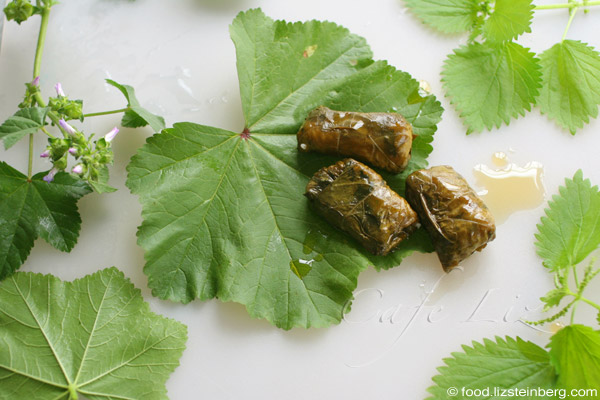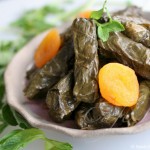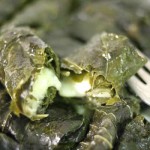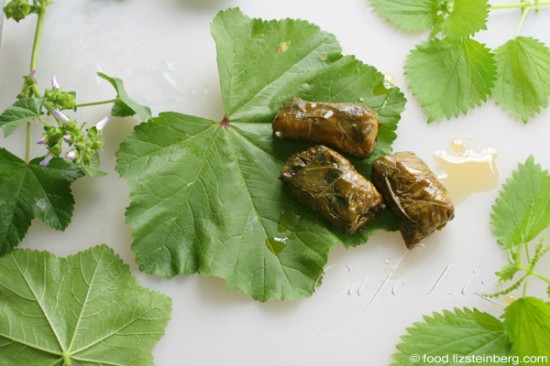
If I’m stuffing foraged mallow leaves, I might as well stuff them with foraged nettle.
I acquired both my mallow and my nettle through the not-so-socially-acceptable (or should I say hippie trendy?) method of picking them from the city’s streets. Both have a long culinary history, but most people aren’t aware of it. Mallow has long been a staple for the region’s poor, and many people here know it as the plant that helped Jerusalemites survive the siege in the War of Independence in 1948. Nettle loses its sting once you blanch it, and it appears in rustic Italian pasta recipes.
Both these plants are readily available in the city’s yards and open spaces. The winter rains wake their seeds, turning the cityscape green. By this point, after three months of rain, the mallows are up to my waist and some of their leaves are larger than my hands. The season for foraging is nearly over — within a few weeks, expect bugs to be feasting on this winter bounty, making it no good for humans.
Mallows can be stuffed just like grape leaves, and since they’re softer, they cook much more quickly — grape leaves need an hour and a half to soften, while mallows need no more time than it takes to cook the rice. In order to play up the wild flavor, I used nettle as my main seasoning, as opposed to a more traditional herb such as parsley or dill. Nettle has a mild flavor that I might even describe as soapy — don’t worry, it’s not a bad thing — and the garlic and onion round it out without overpowering it.
For those who don’t go foraging, you can replace the mallow with grape leaves and the nettle with parsley, and increase the cooking time to 1.5 hours. It’ll be good, but it won’t be this recipe.
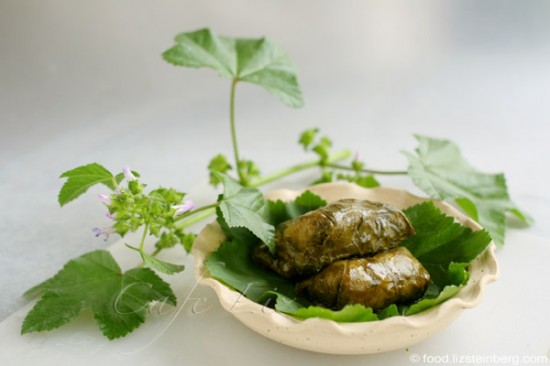
For 30 stuffed mallows:
30 big mallow leaves
1 onion
1/4 cup olive oil
4-6 big garlic cloves
60 g nettle (about 1 cup)
1 cup rice
2 tablespoons lemon
1 teaspoon salt (or more to taste)
Prep: 45 minutes. Cook time: 15 minutes.
Chop the onion, and fry in the olive oil until just translucent. Crush the garlic, add to the pot and cook until browned.
Rinse the nettles well — be careful about touching them if you’re sensitive, you could use gloves or a plastic bag to protect your hands. Chop and add to the pot so that the nettles reduce in size. Add the rice, the lemon and the salt, and cook and stir for a minute or two until some of the liquid boils off or is absorbed by the rice.
Meanwhile, rinse your mallow leaves. Mine sat overnight in the fridge and were therefore quite flexible; if yours are too stiff to work with, quickly blanch them.
Stuff the leaves: Place a leaf vein-side up on the work surface, with the base of the leaf closest to you. Put a heaping teaspoon of filling (or more or less, based on the size of the leaf) next to the base of the leaf, fold over the base to cover the filling, fold in the sides and then roll the leaf up to the tip, to make a little roll (for photo instructions of how to stuff a leaf, see my post on cheese-filled grape leaves. Use no more than the ratio of filling that you see in the photo, since rice expands, unlike cheese).
Arrange the stuffed leaves tightly in a pot that is small enough to let you make several layers (I had about 3 layers). Put a plate on top of them to keep them in place, and then add enough hot water to barely cover the plate. Bring to a boil and cook on the lowest possible flame for about 15 minutes, long enough to cook the rice.
Remove the stuffed leaves from the pot, or if you want to leave them there, hold the plate in place and pour out extra water so that the leaves on the bottom of the pot don’t get bloated.
More:

